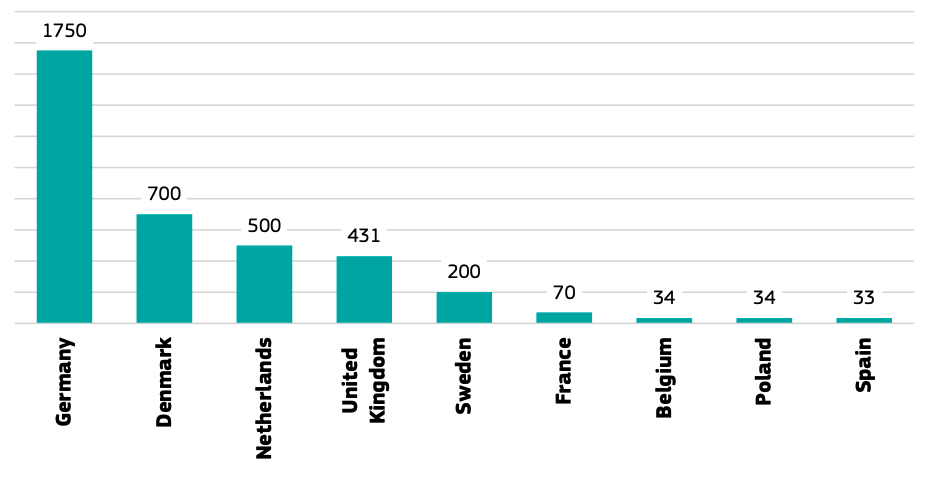The energy transition, supported by growing public awareness of climate change has led to the emergence of energy communities around the world.
What are these Communities and what are their Contributions and Benefits?
Based on individual self-consumption, these communities have been formed to generate and benefit from the electricity generated locally by collaborating with companies, local councils and neighbours. This demonstrates that an increasing number of consumers wants to be active and responsible and thus, are becoming “prosumers” (producers and consumers) of energy.
In this article, you will find out what an energy community is, how this model is evolving in the UK and how it can benefit from the use of an EMS.
The first energy communities were built before a name or a specific regulation was established for them. To regularise and encourage their implementation, the European Union has implemented a regulation defining two concepts: the Citizen Energy Community (Directive (EU) 2019/944) and the Renewable Energy Community (Directive (EU) 2018/2001).
Like other entities, energy communities need governance and regulatory arrangements as they face higher investment risks compared to commercial energy providers. Therefore, the UK government decided that they will benefit from tax-advantaged investment under the SITR (Social Investment Tax Relief).
Before you keep reading, it is important to clarify that energy communities are not competitors of energy providers. They are just another player in the energy market with a local and non-commercial vision. In fact, in many cases, they continue to collaborate with them and with energy services companies to initiate or manage projects. In this article, you can find out more about the role of utilities in self-consumption in the UK.
Key Elements of an Energy Community
As a relatively new model, it can vary, but there are a number of characteristics for a collective self-consumption project to be considered as an Energy Community.
These are:
- Renewable energy. The type of energy produced and consumed in these communities is, by definition, renewable. The project may include electrification, installation of solar panels, district heating networks, heat pumps, biomass or hydroelectric production.
- Geographical location. These are local projects, with buildings and installations within a radius of 500m, typically.
- Legal entity. An energy community is not just a group of consumers, it requires a legal entity to be constituted.
- Voluntary participation. No company or neighbour in the vicinity should be forced to participate. In general, these projects seek consensus and community building. Therefore, they are attractive to many but are not compulsory.
- Collaboration and diversity of participants. Members of communities can be both individuals and legal entities. They can include residential and local administrations, as well as offices, factories or sports facilities. For instance, a residential development that collaborates with a school and an office block, a municipality that cooperates with agriculture, or even a hotel working with its neighbours.
- Search for economic savings without a profit motive. Economic saving is a clear objective along with sustainability, but these communities are not aiming at generating money. Although they can “sell” unused energy to the main grid, this will have an impact on the bills with discounted prices for the community.
Therefore, energy communities create small energy grids (microgrids), independent from the main ones. As seen above, their aim is to benefit local actors by controlling their production, reducing their consumption, making them more efficient and creating community.
If you are thinking of setting up an energy community, the advice of a specialised company can help you in the evaluation and start-up process. Energy Management Systems such as the DEXMA Platform will also be useful in this context. You will be able to analyse the consumption of existing installations, make predictions of your energy production and consumption and also monitor the change once solar panels or other energy generation is installed. If you already have some knowledge on this subject, you can learn more about how DEXMA’s Microgrids application works here.
How are Energy Communities Financed?
The long-term goal is to generate savings, but before this can be achieved, an initial investment is required to install panels, windmills, meters, etc. This first investment can be covered by public subsidies, by companies, energy services companies or neighbours.
The European Union’s Next Generation funds are expected to be a major boost, with the main focus on green energy development and the ecological transition. DEXMA is actively involved in these funds, helping our clients to get funding for their energy efficiency projects.
In the UK, there exist many funding options that fall under six main categories: Grant Funding, Location-based Grant Funding, Council Climate Funds, Grant Funding Organisations, Crowdfunding and Coronavirus Emergency Funding. These fundings cover various aspects of the energy community such as initial advice, installation of panels and meters, energy generation, energy storage, energy efficiency and mobility.
Energy Communities in the UK
As per the State of the Sector report, in 2021 there were about 400 organisations across the UK, with an installed capacity of a total of 319 MW. Economic benefits included £2.9 million on reduced energy bills. At the European level, Germany and Denmark led with 1750 and 700 communities respectively.
Source: European Commission Joint Research Centre
The origin of energy in these communities is diverse, but solar photovoltaic is predominant. The UK has great potential with solar energy but still has significant room for improvement compared to other countries such as the Netherlands, Denmark and Germany.
The solar photovoltaic (PV) sector is on the rise in the UK. 730 MW were installed last year, which represents a rise of 36%. The country now totalises an installed total solar capacity of 14.6 GW, which is enough to generate electricity to power over three million homes.
In 2020, the UK government decided to implement the Smart Export Guarantee Scheme (SGE) available to technologies including PV and allow energy communities among others to sell their excess energy to the government.
These figures show how self-consumption of energy continues to grow, not only in the residential sector, and how the figure of energy communities is key to the local development of renewable energy.
Some of the best known and pioneering examples of energy communities in the UK are:
Baywind Cooperative is considered to be the first energy community in the UK, formed in 1996. Its funds were raised directly from members of the general public, which enabled them to invest in local wind turbines in Cumbria.
Eigg Electric describe themselves as a “community-owned, managed and maintained company which provides electricity for all island residents from the renewable sources of water, sun, and wind.” Thanks to the coordinated efforts of its inhabitants, the Scottish island of Eigg is self-sufficient in terms of energy needs.
Edinburgh Community Solar Cooperative
Edinburgh Community Solar Cooperative generates 1.1GWh of electricity each year. profits are invested in various projects throughout the city of Edinburgh, in order to promote renewable energy.
Community Energy Scotland offers technical support for community project development in green energy and energy conservation. It is an independent organisation whose mission is to build a more democratic energy system.
Leominster Community Solar generated electricity for a community building in the city. By doing so, they offer local people the opportunity to invest in renewable, clean and green energy. To realise this project, LCS raised £150,725 from 94 locals.
BWCE is a non-profit community benefit organisation founded in 2010. So far, they have installed 12.35MW of renewable energy, powering about 4’000 homes. BWCE have raised about £20 million to build their projects.
Energy Efficiency in Energy Communities
Participation at a local level in an energy community makes the members aware of and involved in energy efficiency and energy savings.
In addition, before launching into energy production, many of these projects include energy efficiency actions for the improvement of buildings, including insulation, window renovation, etc. In some cases, energy management systems (EMS) such as the DEXMA Platform are also used to forecast, monitor progress and evaluate projects.
For instance, some communities outsource management to a consultancy or marketing company. In this situation, the management company can use the DEXMA Platform to monitor, evaluate results and identify areas for growth.
In addition, you can also use the tool to share information with community members, produce individualised reports for each building or location (shops, offices, flats, etc.), and process invoices. In this case, each company, shop, municipality or neighbour of the community can have access accounts to the platform to track and compare data.
If you would like to know more about how DEXMA can be useful in your energy community, or how to use our Microgrid solution and application, please contact us.





